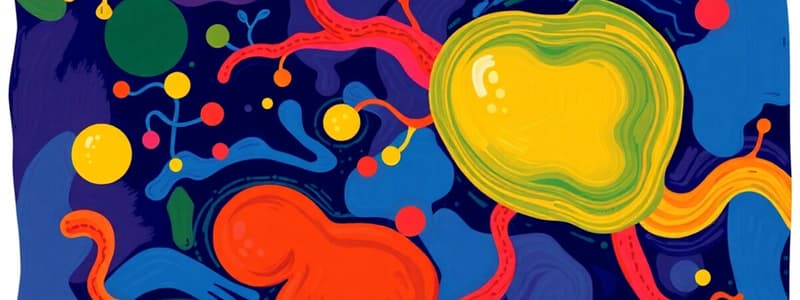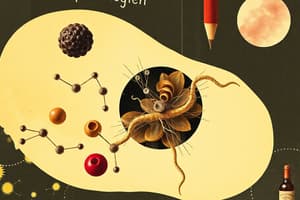Podcast
Questions and Answers
What is the primary form in which lipids are ingested in the diet?
What is the primary form in which lipids are ingested in the diet?
- Phospholipids
- Free fatty acids
- Cholesterol
- Triglycerides (correct)
Which enzyme is primarily responsible for breaking down triglycerides in the intestine?
Which enzyme is primarily responsible for breaking down triglycerides in the intestine?
- Pancreatic lipase (correct)
- Phospholipase A1
- Cholesterol oxidase
- Lipoprotein lipase
What condition results from a daily excretion of fat in feces exceeding 6 grams?
What condition results from a daily excretion of fat in feces exceeding 6 grams?
- Cholecystitis
- Malabsorption syndrome
- Steatorrhea (correct)
- Obstructive jaundice
Which of the following diseases is associated with defective absorption of lipids?
Which of the following diseases is associated with defective absorption of lipids?
What role do mixed micelles play in lipid digestion?
What role do mixed micelles play in lipid digestion?
What is the primary dietary lipid ingested by humans?
What is the primary dietary lipid ingested by humans?
Which enzyme initiates lipid digestion in the mouth?
Which enzyme initiates lipid digestion in the mouth?
What is the optimum pH for gastric lipase activity?
What is the optimum pH for gastric lipase activity?
What is required for the emulsification of lipids in the small intestine?
What is required for the emulsification of lipids in the small intestine?
Which of the following describes mixed micelle formation?
Which of the following describes mixed micelle formation?
What percentage of triglyceride digestion occurs in the stomach?
What percentage of triglyceride digestion occurs in the stomach?
What condition could be suggested by oily stools and increased stool fat?
What condition could be suggested by oily stools and increased stool fat?
What role does colipase play in lipid digestion?
What role does colipase play in lipid digestion?
What are the main end products formed from the action of pancreatic lipase on triacylglycerols?
What are the main end products formed from the action of pancreatic lipase on triacylglycerols?
How does the absorption of the digestive products occur in the small intestine?
How does the absorption of the digestive products occur in the small intestine?
What is a characteristic feature of chylomicrons?
What is a characteristic feature of chylomicrons?
What is the primary method through which short chain fatty acids (SCF) are absorbed?
What is the primary method through which short chain fatty acids (SCF) are absorbed?
Which enzyme is responsible for clearing chylomicrons from the circulation?
Which enzyme is responsible for clearing chylomicrons from the circulation?
What percentage of the resulting products from lipid digestion is made up of 2-MAG?
What percentage of the resulting products from lipid digestion is made up of 2-MAG?
Which component does not require enzymatic digestion during lipid absorption?
Which component does not require enzymatic digestion during lipid absorption?
What is the main role of mixed micelles in lipid digestion and absorption?
What is the main role of mixed micelles in lipid digestion and absorption?
Flashcards are hidden until you start studying
Study Notes
Lipid Digestion
- Dietary lipids are ingested in the form of triglycerides (90%), cholesterol, phospholipids, and free fatty acids.
- Lipids are digested in the mouth by lingual lipase, which primarily acts on short chain triglycerides (SCTs).
- Gastric lipase is responsible for digestion in the stomach.
- Up to 30% of triglycerides are digested in the stomach.
- The small intestine is where the majority of lipid digestion occurs.
- Bile salts, mechanical agitation in the gut, colipase, and phospholipids are essential for emulsification of lipids in the aqueous environment of the small intestine.
- Emulsified fats are degraded by pancreatic lipases, including lipase and phospholipase A2.
- Pancreatic lipase breaks down triacylglycerols into two fatty acids and one mono-acylglycerol.
- Phospholipase A2 breaks down phospholipids into a fatty acid and a lysophospholipid.
- Cholesterol ester hydrolase (esterase) breaks down cholesterol esters into a fatty acid and cholesterol.
- Isomerase shifts the position of fatty acids, allowing lipase to break down the first position and form free glycerol and fatty acids.
- The major end products of lipid digestion are 2-MAG (78%), 1-MAG (6%), glycerol, and fatty acids (14%).
- Cholesterol and fat-soluble vitamins do not require enzymatic digestion.
Lipid Absorption
- The products of lipid digestion are absorbed by forming mixed micelles with bile salts.
- Micelles aid in moving fat products close to the microvilli in the small intestine.
- Microvilli facilitate the absorption process.
- Fat digested products are transported across intestinal cell membranes through diffusion.
- Resynthesis of triacylglycerols occurs within the intestinal cells after the absorption of digested lipid products.
- Triacylglycerols are stored in lipoprotein complexes called chylomicrons.
- Chylomicrons contain lipid droplets surrounded by polar lipids and a layer of proteins.
- Short chain fatty acids (SCF) and medium chain fatty acids (MCF) are readily absorbed and do not require re-esterification.
- SCF and MCF are found in milk, butter, ghee, coconut oil, and mother's milk.
- They enter the bloodstream through the portal vein and are utilized for energy by the liver.
- Long chain fatty acids are stored in adipose tissue or oxidized for energy by other tissues.
- Chylomicrons in circulation cause turbidity in serum, which is cleared by lipoprotein lipase (LPL), also known as clearing factor.
- LPL breaks down triacylglycerols into two fatty acids and one mono-acylglycerol, and glycerol is utilized by the liver or other tissues containing glycerol kinase.
Abnormalities in Lipid Digestion and Absorption
- Steatorrhea, defined as daily excretion of fat in feces exceeding 6 grams, is indicative of defective digestion, often seen in pancreatic diseases.
- Defective absorption, which can lead to steatorrhea, can result from diseases such as celiac disease, sprue, Crohn's disease, surgical removal of the intestine, or bile duct obstruction.
- Milk fat and coconut oil, composed of MCT, are therapeutically beneficial in malabsorption syndrome due to their efficient absorption.
Summary
- Lipids are essential in the diet, primarily in the form of triglycerides.
- Emulsification increases the surface area for enzyme function in lipid digestion.
- The small intestine is the site of lipid digestion by pancreatic lipase, cholesterol esterase, and phospholipase A2.
- Digested lipids are transported in mixed micelles and absorbed by the small intestine.
- Triacylglycerols are then packaged into chylomicrons for transportation in the bloodstream.
- Lipoprotein lipase (LPL) breaks down chylomicron triacylglycerols, releasing fatty acids for energy or storage.
- Defective digestion or absorption of lipids can lead to steatorrhea and are associated with various diseases.
Studying That Suits You
Use AI to generate personalized quizzes and flashcards to suit your learning preferences.




